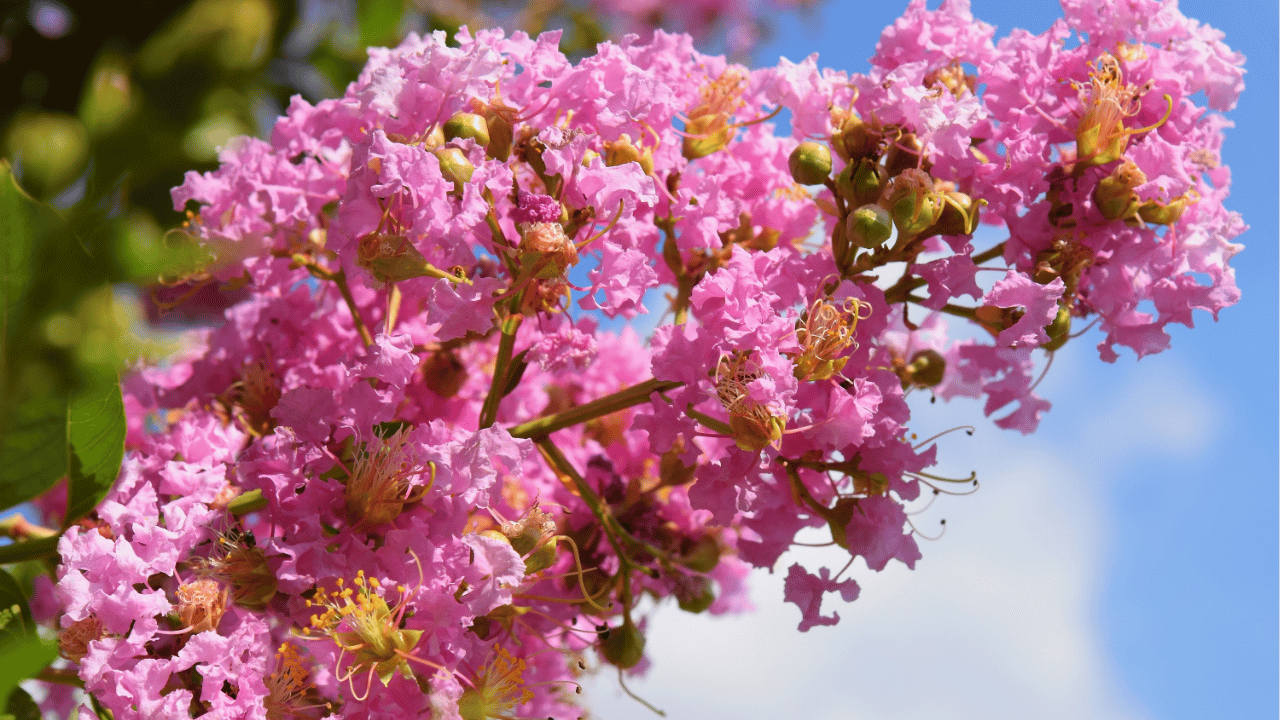Caring for crepe myrtle trees ensures they thrive with vibrant blooms and healthy foliage. Although they’re known for being hardy and adaptable, providing specific attention to their needs can greatly enhance their growth and flowering potential. Below are ten essential tips to help experienced gardeners maximize the beauty and longevity of their crepe myrtles, from pruning techniques to disease prevention.
1. Prune at the Right Time
Pruning is crucial for maintaining the shape and health of your crepe myrtle. Always prune during the late winter when the tree is dormant, as this reduces the risk of infection and encourages strong growth in the spring. Avoid heavy pruning, often called “crepe murder,” which can weaken the tree and reduce its flowering capacity.
Focus on removing dead or crossing branches, which can create a cluttered appearance and hinder airflow. Be precise and gentle in your cuts to maintain the natural structure, allowing the tree to flourish with a more open and graceful form in the growing season.
2. Provide Full Sunlight
Crepe myrtles thrive in full sun, needing at least 6 hours of direct sunlight daily to produce abundant blooms. Without enough sunlight, you might notice fewer or smaller flowers, as the tree diverts energy to survive rather than blossom. Place your crepe myrtle in an area with ample exposure to the sun.
In shadier spots, you may experience more leggy growth, where the tree stretches towards the light, leading to weaker stems. Monitoring and adjusting the light conditions ensures your crepe myrtle has a full canopy of healthy leaves and a strong blooming cycle.
3. Water Deeply but Infrequently
Crepe myrtles are drought-tolerant once established, but during the first few years, regular deep watering is vital. Aim to water deeply once a week, especially during dry spells, to encourage deep root growth. Shallow watering promotes surface roots, making the tree more vulnerable to drought.
Ensure the soil drains well, as waterlogged roots can lead to rot. Check the moisture level around the tree base; if it feels dry a few inches down, it’s time to water. Proper hydration practices ensure strong roots and consistent flowering.
4. Fertilize Sparingly
While crepe myrtles do benefit from fertilization, too much nitrogen can lead to excessive leafy growth at the expense of flowers. Use a balanced fertilizer in early spring, but avoid over-fertilizing, as it can result in fewer blooms and potentially weaken the tree.
Opt for slow-release fertilizers, which offer steady nourishment throughout the growing season. Alternatively, adding organic matter like compost around the base of the tree can provide a gentler, more sustainable source of nutrients.
5. Mulch to Retain Moisture
Applying mulch around your crepe myrtle helps retain moisture, keeps the roots cool, and suppresses weed growth. Spread a 2-3 inch layer of organic mulch, such as pine straw or wood chips, around the base of the tree, but avoid piling it against the trunk.
Mulching also protects the roots from extreme temperature fluctuations, ensuring the tree stays hydrated during hot summers and insulated in colder months. Refresh the mulch annually, keeping the area neat and effective in moisture retention.
6. Choose the Right Variety for Your Climate
Crepe myrtles come in many varieties, each with different tolerances for temperature and humidity. Choose a variety that suits your climate to ensure it thrives. Some cultivars are more cold-hardy, while others excel in warmer regions.
Research local nursery recommendations, and opt for disease-resistant varieties when available. A well-suited tree will require less maintenance and will be better equipped to resist pests and environmental stress.
7. Prevent Powdery Mildew
Powdery mildew can be a persistent issue, especially in humid climates. To prevent this unsightly fungal disease, ensure proper air circulation around the tree by pruning and spacing multiple trees adequately apart. Also, select mildew-resistant varieties to reduce the chances of infection.
If mildew appears, treat with fungicides specifically formulated for crepe myrtles or apply neem oil, a natural alternative. Early detection and treatment keep this disease from spreading, allowing the tree to maintain its ornamental appeal.
8. Control Pests Naturally
Aphids and Japanese beetles are common pests that can damage crepe myrtle leaves and buds. Introduce beneficial insects like ladybugs and lacewings to your garden, which naturally keep aphid populations in check. For beetles, hand-pick or use traps to control infestations.
Avoid harsh pesticides, as they can harm beneficial insects. Instead, try insecticidal soaps or neem oil sprays, which are less harmful to the environment and still effectively manage pests without disrupting your garden’s ecosystem.
9. Space Trees Properly
When planting multiple crepe myrtles, ensure they have adequate spacing to avoid overcrowding. Proper spacing promotes airflow, reduces the risk of disease, and allows each tree to reach its full potential. Most standard varieties need about 15-20 feet of space, while dwarf varieties can be planted closer together.
Overcrowded trees often suffer from poor air circulation, leading to fungal infections and pest problems. Adequate spacing ensures that each tree has enough room to develop a healthy structure and full canopy.
10. Monitor and Maintain Soil pH
Crepe myrtles prefer slightly acidic soil with a pH between 5.5 and 6.5. Test your soil every couple of years to ensure it’s within the right range. If your soil is too alkaline, amend it with sulfur or organic materials like pine needles to lower the pH.
Acidic soil helps crepe myrtles absorb essential nutrients, leading to stronger growth and more vibrant blooms. Maintaining the correct soil pH ensures that your crepe myrtle has the optimal conditions to thrive year after year.

